The Intel SSD 710 (200GB) Review
by Anand Lal Shimpi on September 30, 2011 8:53 PM EST- Posted in
- Storage
- SSDs
- Intel
- Intel SSD 710
AnandTech Storage Bench 2011
Last year we introduced our AnandTech Storage Bench, a suite of benchmarks that took traces of real OS/application usage and played them back in a repeatable manner. I assembled the traces myself out of frustration with the majority of what we have today in terms of SSD benchmarks.
Although the AnandTech Storage Bench tests did a good job of characterizing SSD performance, they weren't stressful enough. All of the tests performed less than 10GB of reads/writes and typically involved only 4GB of writes specifically. That's not even enough exceed the spare area on most SSDs. Most canned SSD benchmarks don't even come close to writing a single gigabyte of data, but that doesn't mean that simply writing 4GB is acceptable.
Originally I kept the benchmarks short enough that they wouldn't be a burden to run (~30 minutes) but long enough that they were representative of what a power user might do with their system.
Not too long ago I tweeted that I had created what I referred to as the Mother of All SSD Benchmarks (MOASB). Rather than only writing 4GB of data to the drive, this benchmark writes 106.32GB. It's the load you'd put on a drive after nearly two weeks of constant usage. And it takes a *long* time to run.
1) The MOASB, officially called AnandTech Storage Bench 2011 - Heavy Workload, mainly focuses on the times when your I/O activity is the highest. There is a lot of downloading and application installing that happens during the course of this test. My thinking was that it's during application installs, file copies, downloading and multitasking with all of this that you can really notice performance differences between drives.
2) I tried to cover as many bases as possible with the software I incorporated into this test. There's a lot of photo editing in Photoshop, HTML editing in Dreamweaver, web browsing, game playing/level loading (Starcraft II & WoW are both a part of the test) as well as general use stuff (application installing, virus scanning). I included a large amount of email downloading, document creation and editing as well. To top it all off I even use Visual Studio 2008 to build Chromium during the test.
The test has 2,168,893 read operations and 1,783,447 write operations. The IO breakdown is as follows:
| AnandTech Storage Bench 2011 - Heavy Workload IO Breakdown | ||||
| IO Size | % of Total | |||
| 4KB | 28% | |||
| 16KB | 10% | |||
| 32KB | 10% | |||
| 64KB | 4% | |||
Only 42% of all operations are sequential, the rest range from pseudo to fully random (with most falling in the pseudo-random category). Average queue depth is 4.625 IOs, with 59% of operations taking place in an IO queue of 1.
Many of you have asked for a better way to really characterize performance. Simply looking at IOPS doesn't really say much. As a result I'm going to be presenting Storage Bench 2011 data in a slightly different way. We'll have performance represented as Average MB/s, with higher numbers being better. At the same time I'll be reporting how long the SSD was busy while running this test. These disk busy graphs will show you exactly how much time was shaved off by using a faster drive vs. a slower one during the course of this test. Finally, I will also break out performance into reads, writes and combined. The reason I do this is to help balance out the fact that this test is unusually write intensive, which can often hide the benefits of a drive with good read performance.
There's also a new light workload for 2011. This is a far more reasonable, typical every day use case benchmark. Lots of web browsing, photo editing (but with a greater focus on photo consumption), video playback as well as some application installs and gaming. This test isn't nearly as write intensive as the MOASB but it's still multiple times more write intensive than what we were running last year.
As always I don't believe that these two benchmarks alone are enough to characterize the performance of a drive, but hopefully along with the rest of our tests they will help provide a better idea.
The testbed for Storage Bench 2011 has changed as well. We're now using a Sandy Bridge platform with full 6Gbps support for these tests. All of the older tests are still run on our X58 platform.
AnandTech Storage Bench 2011 - Heavy Workload
We'll start out by looking at average data rate throughout our new heavy workload test:
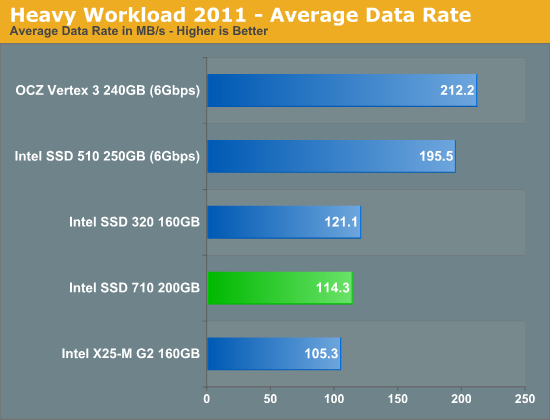
I threw in our standard desktop tests just to hammer home the point that the 710 simply shouldn't be used for client computing. Not only is MLC-HET overkill for client workloads, but the Intel SSD 320's firmware is better optimized for client computing.
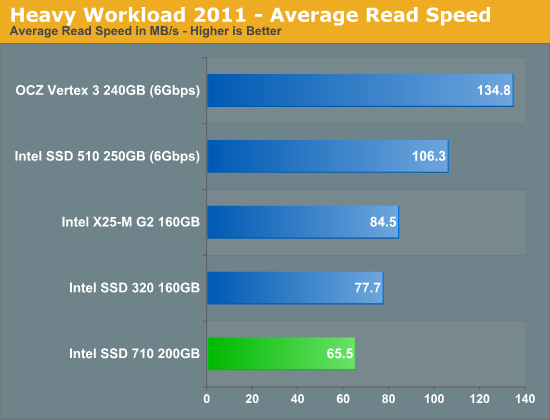
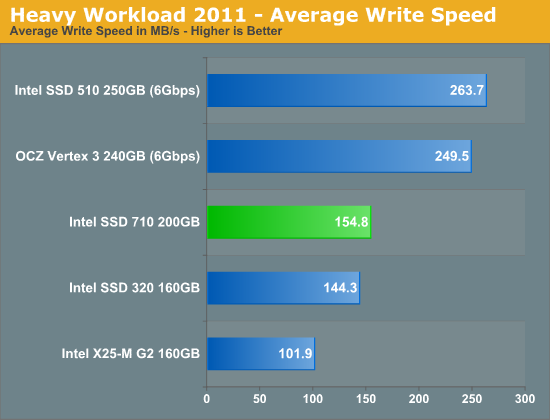
The next three charts just represent the same data, but in a different manner. Instead of looking at average data rate, we're looking at how long the disk was busy for during this entire test. Note that disk busy time excludes any and all idles, this is just how long the SSD was busy doing something:
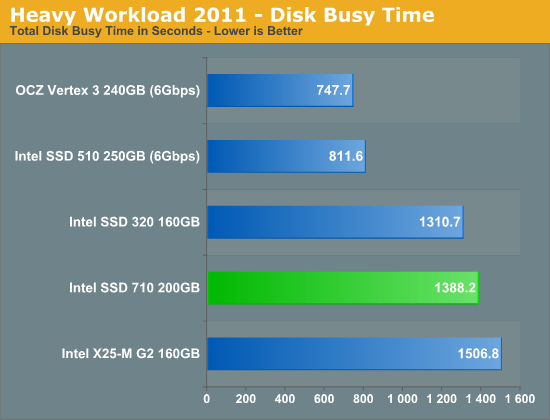
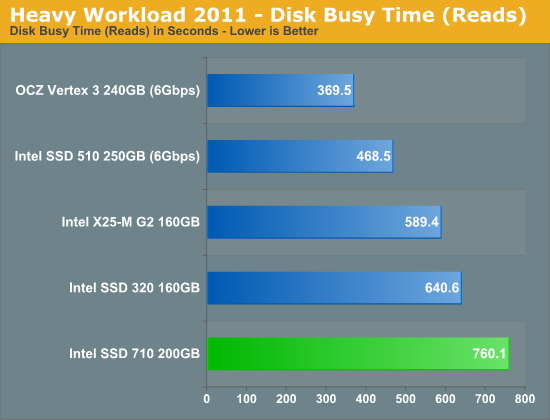
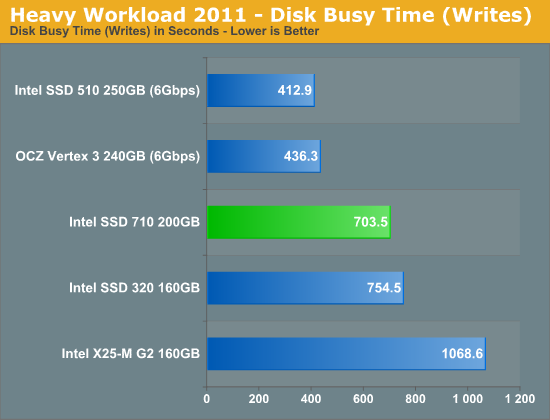










68 Comments
View All Comments
Stas - Sunday, October 2, 2011 - link
Makes you wonder: how did Anandtech survive in the olden days?Anand Lal Shimpi - Friday, September 30, 2011 - link
I didn't preview Bulldozer because it would've been a disservice to the community. The performance levels of chips we had access to prior to going under NDA with AMD just wasn't representative of anything.Don't worry, you'll get to hear about Bulldozer soon enough :) AMD said shipping in Q4...
Take care,
Anand
Voidman - Friday, September 30, 2011 - link
I actually would have agreed with this comment a lot more a year ago, or even 6 months ago. I am starting to see a few actual PC builder related reviews in recent months, and am happy about it. (Of course consumer SSD's are of interest to home builders, but that was about the only thing here that was). I was pleasntly surprised to see several reviews on cases/enclosures, something I have not seen here for a long time. And a PSU and monitor review here and there also. All of this came too late for my last build, but it is nice to see anyway.It does seem that there was a decision a couple of years ago to concentrate on smart phones and tablets and home theater gear, with SSD and enterprise IT articles filling in the gaps. I hope the recent trend of more PC builder related articles and reviews continues.
kevith - Saturday, October 1, 2011 - link
Apples products are interesting because they show the way. Tablets, phones and OS, they have the best. (And most expensive and hyped and with a congregation that's gross). But when Apple launches a product, EVERYONE else will try to copy it within months, whether you like it or not. Thats why its interesting reading.Enterprise hardware is interesting to read about because it shows what a new piece of hardware are ACTUALLY capable of. In this case it shows, that if you want a real reliable SSD, the "nickels and dimes", that a consumer-SSD costs is simply not enough.
THizzle7XU - Saturday, October 1, 2011 - link
"Apples products are interesting because they show the way."I actually feel like the media at this point puts Apple in a position to create a self fulfilling prophecy in this regard. The iPad is the greatest example of this. Before the iPad came out there were rumors for years, pretty much since the iPhone debut, that Apple was working on a tablet and how it would be the greatest thing ever. I feel like after the rumors went on for a while, Apple was like, "Ya, this thing sounds cool! Maybe we should build a tablet!". And then all the other manufactures sat on their hands while the obvious was happening waiting for Apple to release the design template when the blueprint was crystal clear for tablets (i.e. just their phone OS on a bigger screen with slight modifications to the apps to take advantage of the screen res).
It's like Apple pays its competitors not to compete with its ideas until they have released their product. And they everyone else becomes a copy cat of ideas that were so painfully obvious in the first place because they inexplicably waited until Apple released their version.
Stas - Sunday, October 2, 2011 - link
How dare you?! Steve Jobs created the universe. zOMG I'm getting wet dreaming about iPhone 5 !!!11!11!111inplainview - Sunday, October 2, 2011 - link
I must suck being you....Hulk - Friday, September 30, 2011 - link
I've been here from day one and Anand keeps getting better. In my opinion he has always been the best tech writer on the internet and now I see his thoughts are as clear an organized when doing a video review. Bravo!Kudos to all of the guys on the Anandtech site. The flavor of all of the reviews flows down to everyone here. Anand is still the best but luckily he is rubbing off on all his guys.
wxrkny - Friday, September 30, 2011 - link
"Anand is still the best but luckily he is rubbing off on all his guys."I hope not, that's gross
sorry I had to
TommyAU - Friday, September 30, 2011 - link
Haha